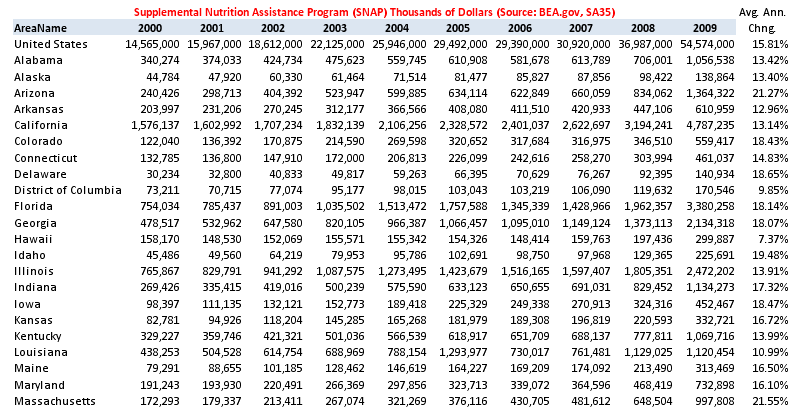Invictus here, gang, with a little pre-election number crunching.
I posted recently on the explosive growth in the use of food stamps, now known as the Supplemental Nutrition Assistance Program (SNAP). BR asked some very relevant questions, and commenter Kort provided some interesting linkage that gave a history of the program, including various changes made along the way (which helped explain the recent surge). That post generated a fair amount of commentary.
I’ve been (as always) rooting around the various features of the BEA.gov website (interesting life, eh?), and dug deeply into this set of interactive maps. As I have a strong curiosity about how people vote against their own self-interest, I’ve spent a fair amount of time exploring Personal Current Transfer Receipts (PCTR) — government largesse to those in need (specifically defined as: “Consists of income payments to persons for which no current services are performed and net insurance settlements.” Emphasis added.) It would seem to me fairly straightforward that those who rely – or may – on any portion of PCTR would be loathe to see its various programs gutted.
Other areas within PCTR that I’ve been examining in addition to SNAP, on a state-by-state basis, are the usual targets of the Cutback Crowd, such as Medicare, Family Assistance, Unemployment Insurance. I’ve even begun to analyze the data on a county basis (more on that below). The results are fascinating.
But back to SNAP, as that’s what got me started with this follow-up post. Below are the year-by-year levels (000’s) of SNAP dollars by state for the period from 2000 through 2009. A Google search on “where is Tea Party strongest” returns this Rasmussen report from June among its results. At 45 seconds in we learn that Tea Party affiliation is strongest in CO, KY, AL, AZ and GA. Interestingly, the growth in SNAP in three of those states — AZ, CO and GA — exceeds the national average over the period from 2000 – 2009.
(Click through for entire table, which can also be seen at its source here.)
A similar pattern for these five states, i.e. higher than the national average in various sub-components of PCTR, is evident in Medicare, Family Assistance, and Unemployment Insurance, to name three:
Source Tables: Medicare, Family Assistance, Unemployment Insurance
This pattern is not confined to the five states that Rasmussen reports identify most closely with the tea baggers. Indeed, I see it over and over again in the data.
The county level is truly fascinating, and I’ve only just begun to explore it.
According to data I’ve compiled from USA Today and the BEA, there were eight counties in 2004 (and with the benefit of data since then) that met the following criteria:
- Cast more than 10,000 votes for Bush (in 2004) which
- Gave Bush more than 80% of the vote, AND
- For the subsequent period from 2005 through 2008, these counties exceeded the average annual national growth rate in:
- Unemployment Insurance
- Medicare
- SNAP
Three are in Alabama: Blount, Shelby and St. Clair. Three are in Utah: Cache, Iron and Washington. One is in Georgia: Forsyth. And the winner — giving astounding 93% of its vote to Bush in 2004 and 85% to McCain in 2008, all the while sucking on the public teat big time — is Madison, ID. These counties would seem to be the poster children for COPB — Cutting Other People’s Benefits — because the numbers clearly indicate that they’re sure not cutting their own.
I hope to spend a bit more time analyzing the seeming hypocrisy of voting for small government, cutbacks, deficit reductions, “personal responsibility,” etc., while simultaneously milking the very system against which one rails. Is it really all about social issues (gay marriage, abortion, guns, etc.?). Is that even possible?
Whether or not you vote your self-interest, please do exercise your right to vote tomorrow.
(Interestingly, Paul Krugman’s Nov. 1 column touches tangentially on this issue.)
And a plea for help: I’ve still not figured out how to easily insert an Excel table into WordPress. If anyone could offer a hand with that, perhaps you could ping BR and let him know, or alternatively drop a note in comments? I’m familiar with the HTML (<td>, <tr>, etc.), but it still seems like too much damn work, and frequently seems to bomb out on me and not produce the intended result. I had a couple of tables for this post that I simply scrapped because the job became too onerous; they were very illustrative, informative, and would have added much to the message. And yes, I’ve tried Tableizer, without much success.




What's been said:
Discussions found on the web: